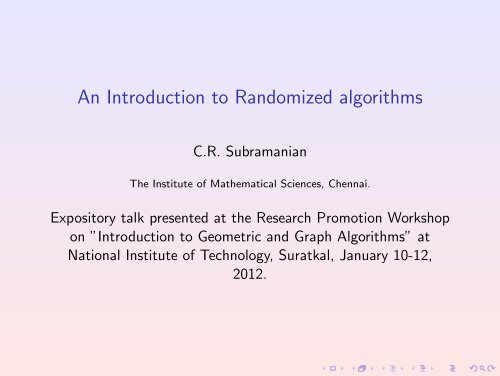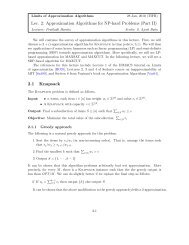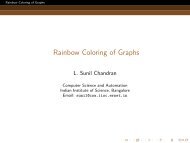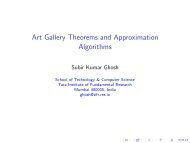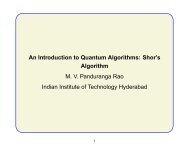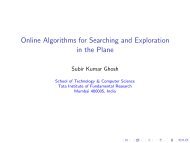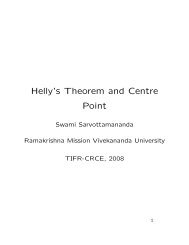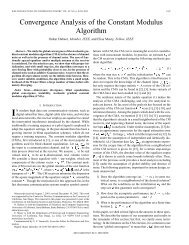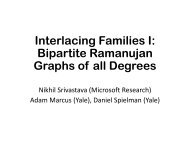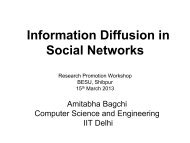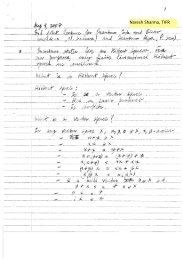An Introduction to Randomized algorithms - School of Technology ...
An Introduction to Randomized algorithms - School of Technology ...
An Introduction to Randomized algorithms - School of Technology ...
You also want an ePaper? Increase the reach of your titles
YUMPU automatically turns print PDFs into web optimized ePapers that Google loves.
<strong>An</strong> <strong>Introduction</strong> <strong>to</strong> <strong>Randomized</strong> <strong>algorithms</strong>C.R. SubramanianThe Institute <strong>of</strong> Mathematical Sciences, Chennai.Exposi<strong>to</strong>ry talk presented at the Research Promotion Workshopon ”<strong>Introduction</strong> <strong>to</strong> Geometric and Graph Algorithms” atNational Institute <strong>of</strong> <strong>Technology</strong>, Suratkal, January 10-12,2012.
<strong>Randomized</strong> AlgorithmsA deterministic algorithm + auxiliary input <strong>of</strong> a sequence <strong>of</strong>unbiased and independent random bits.RA - a randomized algorithm <strong>to</strong> solve π.At every point during an execution <strong>of</strong> algorithm RA over I ,the next move <strong>of</strong> A can possibly be determined by employingrandomly chosen bits and is not uniquely well-defined.The execution and running time, intermediate steps and thefinal output computed could possibly vary for differentexecutions <strong>of</strong> RA over the same I .
Why Randomization ?Randomness <strong>of</strong>ten helps in significantly reducing the workinvolved in determining a correct choice when there areseveral but finding one is very time consuming.Reduction <strong>of</strong> work (and time) can be significant on theaverage or in the worst case.Randomness <strong>of</strong>ten leads <strong>to</strong> very simple and elegantapproaches <strong>to</strong> solve a problem or it can improve theperformance <strong>of</strong> the same algorithm.Risk : loss <strong>of</strong> confidence in the correctness. This loss can bemade very small by repeated employment <strong>of</strong> randomness.Assumes the availability <strong>of</strong> truly unbiased random bits whichare very expensive <strong>to</strong> generate in practice.
Some Tail InequalitiesX - random variable : µ = E[X ]; Var(X ) = E[X 2 ] − µ 2 .Markov : X is nonnegative ;For every t > 0, Pr(X ≥ t) ≤ µ/t.Chebyschev : ∀t > 0, Pr(|X − µ| ≥ t) ≤ Var(X )/t 2 .∀ɛ ∈ (0, 1], Pr(|X − µ| ≥ ɛµ) ≤ Var(X )/ɛ 2 µ 2 .Chern<strong>of</strong>f : X = X 1 + . . . + X n ; X i ∈ {0, 1}. independent.∀ɛ ∈ (0, 1], Pr(X ≤ µ(1 − ɛ)) ≤ e −ɛ2 µ/2 .∀ɛ ∈ (0, 1], Pr(X ≥ µ(1 + ɛ)) ≤ e −ɛ2 µ/3 .
Verifying matrix multiplication :A, B, C ∈ F n×n ; Goal : To verify if AB = C.direct approach - O(n 3 ) time.algebraic approach - O(n 2.376 ) time.<strong>Randomized</strong> Alg :Choose u.a.r. r ∈ {0, 1} n and check if ABr = Cr.If so, output YES, otherwise output NO.If AB ≠ C, then Pr(ABr = Cr) ≤ 1/2.requires O(n 2 ) time.<strong>An</strong> example <strong>of</strong> a Monte-Carlo algorithm : can be incorrect butguaranteed running time and with a guarantee <strong>of</strong> confidence.
QuickSort(A, p, q):If p ≥ q, EXIT.s ← correct position <strong>of</strong> A[p] in the sorted order.Move the ”pivot” A[p] in<strong>to</strong> position s.Move the remaining elements in<strong>to</strong> ”appropriate” positions.Quicksort(A, p, s − 1);Quicksort(A, s + 1, q).
Worse-case Complexity <strong>of</strong> QuickSort :T (n) = Worst-case Complexity <strong>of</strong> QuickSort on an input <strong>of</strong>size n. Only comparisons are counted.T (n) = max{T (π) : π is a permutation <strong>of</strong> [n]}.T (n) = Θ(n 2 ).Worst case input is : π = 〈n, n − 1, . . . , 1〉.There exist inputs requiring Θ(n 2 ) time.
<strong>Randomized</strong> Version : RandQSort(A, p, q):If p ≥ q, EXIT.Choose uniformly at random r ∈ {p, . . . , q}.s ← correct position <strong>of</strong> A[r] in the sorted order.Move randomly chosen pivot A[r] in<strong>to</strong> position s.Move the remaining elements in<strong>to</strong> ”appropriate” positions.RandQSort(A, p, s − 1);RandQSort(A, s + 1, q).
<strong>An</strong>alysis <strong>of</strong> RandQSort :Every comparison is between a pivot and another element.two elements are compared at most once.rank <strong>of</strong> an element is the position in the sorted order.x i is the element <strong>of</strong> rank i. S i,j = {x i , . . . , x j }.X i,j = 1 if x i and x j are ever compared and 0 otherwise.E[T (π)] = E[ ∑ i
Example <strong>of</strong> randomness improving the efficiency :<strong>An</strong>alysis holds for every permutation π.T (n) = Maximum value <strong>of</strong> the Expected Time Complexity <strong>of</strong>RandQSort on an input <strong>of</strong> size n.T (n) = max{E[T (π)] : π is a permutation <strong>of</strong> [n]}.T (n) = Θ(n(log n)).For every π, Pr(T (π) > 8nH n ) ≤ 1/4.introducing randomness very likely improves the efficiency.<strong>An</strong> example <strong>of</strong> a Las Vegas algorithm : always correct butrunning time varies but with possibly poly expected time.
Las Vegas vs Monte-Carlo :Las Vegas → Monte-CarloA - Las Vegas algo with E[T A (I )] ≤ poly(n) for every I .By incorporating a counter which counts every elementarystep in<strong>to</strong> A and s<strong>to</strong>pping after, say, 4poly(n) steps, one gets apoly time Monte-Carlo algorithm B with a guaranteedconfidence <strong>of</strong> at least 3/4.Monte-Carlo → Las VegasA - Monte-Carlo alg with poly(n) time and 1/poly(n) successprobability. Suppose correctness <strong>of</strong> output can be verified inpoly(n) time.By running the alg A repeatedly (with independent coin<strong>to</strong>sses) until one gets a correct solution, we get a Las Vegasalgo with poly expected time.
Randomization provably helpsA simple counting problem :A[1 . . . n]-array with A i ∈ {1, 2} for every i.f(x) = freq(x) ≥ n/5 for each x ∈ {1, 2}.Goal : Given x ∈ {1, 2} and an ɛ > 0,determine ans : ans ∈ [(1 − ɛ)f (x), (1 + ɛ)f (x)].<strong>An</strong>y deter. alg needs Ω(n) queries in the worst case forɛ = 1/10.∃ rand. alg with O(log n) queries for every fixed ɛ.
Randomization provably helpsRandAlg(A, x, ɛ) :m = 20(log n)/ɛ 2 ; c = 0.for i = 1, . . . , m doChoose uniformly at random j ∈ {1, . . . , n}.if A[j] = x then increment c.endforReturn ans = nc/m.end
Randomization provably helps<strong>An</strong>alysis <strong>of</strong> RandAlg(A, x, ɛ) :X i = 1 if A[j] = x for j chosen in the ith-iteration.c = ∑ i X i;E[X i ] = f (x)/n.µ = E[c] = mf (x)/n ≥ m/5. E[ans] = f (x).Pr(c ∉ [(1 − ɛ)µ, (1 + ɛ)µ]) ≤ 2e −ɛ2 µ/3 = o(n −1 ).(1 − ɛ)f (x) ≤ ans ≤ (1 + ɛ)f (x) with probability 1 − o(1).No. <strong>of</strong> queries = O((log n)/ɛ 2 ).No. <strong>of</strong> queries = O(1) with success probability ≥ 3/4.
Unbiased Estima<strong>to</strong>rA is a randomized algorithm <strong>to</strong> approximate #I .A outputs X such that µ = E[X ] = #I .Pr(X ∉ [(1 ± ɛ)µ]) ≤ Var(X )/ɛ 2 µ 2 by Chebyshev.Var(X ) = O(µ) ⇒ reqd.prob = O(ɛ −2 µ −1 ).Example above : Var(X ) ≤ µ, helps us !Often, X is not so nicely defined and Var(X ) may not besmall compared <strong>to</strong> µ 2 .
Boosting Success Probability - IRun m independent trials <strong>of</strong> A(I , ɛ).Take ans <strong>to</strong> be the numerical average <strong>of</strong> {X 1 , . . . , X m }.E[ans] = µ and Var(ans) = Var(X )/m.Pr(ans ∉ [(1 ± ɛ)µ]) ≤ Var(X )/mɛ 2 µ 2 .Pr(success) ≥ 3/4 provided m ≥ 4E[X 2 ]/ɛ 2 µ 2 .a good approximation efficiently computable.
Boosting success probability - IIA is a randomized algorithm <strong>to</strong> approximate #I .A runs in time poly(n, 1/ɛ) and outputs ans :Pr((1 − ɛ)(#I ) ≤ ans ≤ (1 + ɛ)(#I )) ≥ 1/2 + δ.Run m independent trials <strong>of</strong> A(I , ɛ).Take ans <strong>to</strong> be the median <strong>of</strong> {ans 1 , . . . , ans m }.Pr ((1 − ɛ)(#I ) ≤ ans ≤ (1 + ɛ)(#I )) ≥ 1 − e −δ2m/2 .Pr(success) = 1 − o(n −1 ) provided m ≥ 4(log n)/(δ 2 ).a good approximation efficiently computable.
Approximating Frequency MomentsGiven A = (a 1 , . . . , a m ), a j ∈ {1, . . . , n}.m i = frequency <strong>of</strong> i in A, i ∈ {1, . . . , n}.Determine F k = ∑ i mk iusing ”small” space.F 0 = number <strong>of</strong> distinct elements in A.F 1 = length <strong>of</strong> the sequence A ; F 2 = repeat rate <strong>of</strong> A.Determining F k arises in Data Mining.Suppose we want <strong>to</strong> collect some statistical information froma large stream <strong>of</strong> data without having <strong>to</strong> s<strong>to</strong>re the data.Ω(n) bits needed for any deter. alg approximating F k within aratio <strong>of</strong> 1 ± 0.1.
Approximating F 2 - algorithm (Alon, Matias, Szegedy)V = {v 1 , . . . , v h }, h = O(n 2 ), each v i - a n-vec<strong>to</strong>r <strong>of</strong> ±1.V is four-wise independent. For v ∈ R V , ∀i 1 ≤ . . . ≤ i 4 ,∀(ɛ 1 , . . . ɛ 4 ) ∈ {−1, 1} 4 , Pr(∀j, v(i j ) = ɛ j ) = 1/16.Choose p ∈ R {1, . . . , h} and s<strong>to</strong>re it using O(log n) bits.v p (i) can be found (for a given i) using only O(log n) bits.Z = ∑ i ɛ im i . Z can be computed in one pass usingO(log n + log m) bits.Compute X = Z 2 . space = O(log m + log n).Take s 1 = 16/λ 2 independent samples X j = X and take theiraverage Y .Take s 2 = 2 log(1/ɛ) independent samples Y i = Y and outputtheir median.
Approximating F 2 - analysisE[X ] = E[( ∑ i ɛ im i ) 2 ] = ∑ i m2 i= F 2 .E[X 2 ] = ∑ i m4 i+ 6 ∑ i
<strong>Randomized</strong> RoundingV = {x 1 , . . . x n } boolean variables.F = C 1 ∧ . . . ∧ C m ; each C j is a disjunction <strong>of</strong> literals.Eg : C j = x 1 v x c 4 v x 5.MaxSat(F , V ) : Given F over V , find an assignmentsatisfying the maximum number <strong>of</strong> clauses.This is a NP-hard problem.A simple deterministic alg satisfies at least m/2 clauses.Can we do better ?
<strong>Randomized</strong> Rounding<strong>Randomized</strong> Solution : Choose f : V → {T , F } uar|C j | ≥ k ⇒ Pr(f satisfies C j ) ≥ 2 −k .Leads <strong>to</strong> an randomized approx alg which finds a f satisfyingat least 3m/4 clauses on the average if |C j | ≥ 2 for every j.∀j |C j | ≥ k ⇒ E[#f ] ≥ m(1 − 2 −k ).What if we have a mixture <strong>of</strong> clauses <strong>of</strong> different sizes.E[#f ] = ∑ k m k(1 − 2 −k ) where m k = {j : |C j | = k}.Can we do better ?
LP-based <strong>Randomized</strong> RoundingILP Formulation : Maximize ∑ 1≤j≤m z jsubject <strong>to</strong> : ∑ i∈C +jy i , z j ∈ {0, 1} for every i and j.y i + ∑ i∈C − (1 − y i ) ≥ z j ∀jjLP Relaxation : allow each y i , z j ∈ [0, 1].<strong>An</strong> optimal solution (y ∗i , z∗ j ) i,j <strong>of</strong> a LP can be foundefficiently.Rand. Rounding : Independently and randomly set eachy i = 1 with probability yi ∗ . Let g be the resulting assignment.|C j | = k ⇒ Pr(C j is satisfied by g) ≥ β k zj ∗ whereβ k = 1 − (1 − 1/k) k ≥ 1 − 1/e.E[#f ] ≥ ∑ ∑k j:|C j |=k β kzj∗ ≥ (1 − 1/e)OPT (ILP).
LP-based <strong>Randomized</strong> Roundingβ 1 = 1 and β 2 = 0.75 and β k < 1 − 2 −k for k ≥ 3.Improved Algorithm B :Choose f : V → {T , F } uar and let X 1 be the number <strong>of</strong>clauses satisfied.Run the LP-based <strong>Randomized</strong> Rounding algo and let n 2 bethe number <strong>of</strong> clauses satisfied.Return the best <strong>of</strong> the two solutions found which satisfies atleast max{n 1 , n 2 } clauses.max{E[n 1 ], E[n 2 ]} ≥ (0.75) ∑ j z∗ j≥ (0.75)OPT (ILP).
<strong>Randomized</strong> <strong>algorithms</strong>RA - a poly time rand algo for a decision problem π.each instance has only y/n answer.For I ∈ YES(π), Pr(ans(RA, I ) = y) ≥ 1/2 ;For I ∈ NO(π), Pr(ans(RA, I ) = n) = 1 ;Number <strong>of</strong> bits used r = r(n).RP = {L ⊆ Σ ∗ : ∃ such a rand algo RA for π}.RP ⊆ NP; Is NP ⊆ RP ?RA is a RP algorithm.
Boosting Success Probability - ISuppose we want a confidence <strong>of</strong> 1 − δ.Algorithm RB :Run m independent trials <strong>of</strong> RA(I ).Output y if at least one trial says y ;Otherwise, output n ;T RB (I ) ≤ mT RA (I ).For I ∈ YES(π), Pr(ans(RB(I )) = n) ≤ δprovided m ≥ log 2 (1/δ).To make error prob at most 2 −m , we need mr random bits.Can we do with less random bits ?
Boosting Success Probability - IIChoose R ∈ Z p = {0, . . . , p − 1} u.a.r.Pr(A(x, R) = 1) ≥ 1/2 if x ∈ L and is 0 otherwise.Choose a, b ∈ Z p uniformly and independently at random.Compute R i = ai + b(modp) for 1 ≤ i ≤ t.Each R i is uniformly distributed over Z p .R i s are pairwise independent.Z i = 1 if A(x, R i ) = 1 and is 0 otherwise. Z = ∑ i Z i.E[Z] ≥ t/2 and Var(Z) = ∑ i Var(Z i) ≤ t/4.By Chebyschev, Pr(Z = 0) ≤ 1/t.with just 2r independent bits, we get error prob at most 1/tas against r(log t) random bits required in independent trials.
ConclusionsEmploying randomness leads <strong>to</strong> improved simplicity andimproved efficiency in solving the problem.However, assumes the availability <strong>of</strong> a perfect source <strong>of</strong>independent and unbiased random bits.access <strong>to</strong> truly unbiased and independent sequence <strong>of</strong> randombits is expensive and should be considered as an expensiveresource like time and space. One should aim <strong>to</strong> minimize theuse <strong>of</strong> randomness <strong>to</strong> the extent possible.assumes efficient realizability <strong>of</strong> any rational bias. However,this assumption introduces error and increases the work andthe required number <strong>of</strong> random bits.There are ways <strong>to</strong> reduce the randomness from several<strong>algorithms</strong> while maintaining the efficiency nearly the same.


